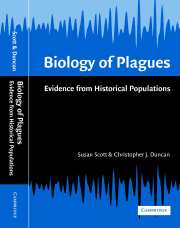Book contents
- Frontmatter
- Contents
- Preface
- Conversion table for imperial to metric units
- 1 Introduction
- 2 Epidemiological concepts
- 3 The biology of bubonic plague
- 4 The Great Pestilence
- 5 Case study: the plague at Penrith in 1597–98
- 6 Pestilence and plague in the 16th century in England
- 7 Plagues in the 16th century in northern England: a metapopulation study
- 8 Plagues in London in the 17th century
- 9 Plagues in the provinces in the 17th century
- 10 Plague at Eyam in 1665–66: a case study
- 11 Continental Europe during the third age of plagues: a study of large-scale metapopulation dynamics
- 12 The plague at Marseilles, 1720–22: an outbreak of bubonic plague?
- 13 Conclusions
- References
- Index
9 - Plagues in the provinces in the 17th century
Published online by Cambridge University Press: 28 October 2009
- Frontmatter
- Contents
- Preface
- Conversion table for imperial to metric units
- 1 Introduction
- 2 Epidemiological concepts
- 3 The biology of bubonic plague
- 4 The Great Pestilence
- 5 Case study: the plague at Penrith in 1597–98
- 6 Pestilence and plague in the 16th century in England
- 7 Plagues in the 16th century in northern England: a metapopulation study
- 8 Plagues in London in the 17th century
- 9 Plagues in the provinces in the 17th century
- 10 Plague at Eyam in 1665–66: a case study
- 11 Continental Europe during the third age of plagues: a study of large-scale metapopulation dynamics
- 12 The plague at Marseilles, 1720–22: an outbreak of bubonic plague?
- 13 Conclusions
- References
- Index
Summary
As we have seen, the plague in London in the later part of the 16th century broke out sporadically and the epidemics steadily increased in intensity whilst it grumbled on in the interepidemic years (section 6.2), becoming endemic in the 17th century with outbreaks of unparalleled ferocity and mortality (Chapter 8). Meanwhile, there were many reports of widespread outbreaks scattered through the provinces throughout the 16th century (section 6.3). Parish registers were required by law to record burials from pestilence during the Elizabethan period but even though these provide a great deal of invaluable information (much of which has still to be extracted and analysed), it is difficult to discern a pattern in the underlying epidemiology of these outbreaks in the provinces. In general, these provincial outbreaks do not appear to have come from a focus in London. Were there many introductions of the disease via the Kent coast (e.g. in 1532), the south coasts (e.g. in 1544 and 1590) and the East Anglian ports (e.g. in 1585), or was the infection grumbling on through the century with low infectivity (R0 ≤ 1) but spread widely by apparently healthy carriers (because of the long incubation period), with epidemics flaring up when and where the conditions were right? Improved communications and much wider travel associated with the wool trade would have exacerbated the spread (see discussion in section 13.9).
- Type
- Chapter
- Information
- Biology of PlaguesEvidence from Historical Populations, pp. 225 - 260Publisher: Cambridge University PressPrint publication year: 2001



